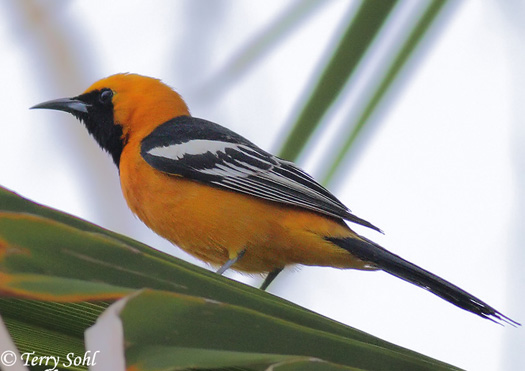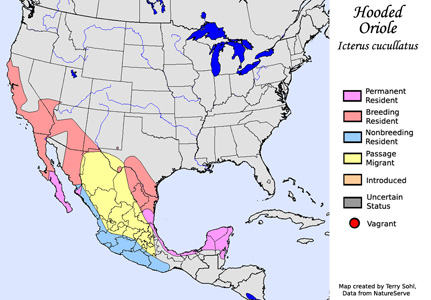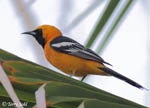| Length: 8 inches | Wingspan: 10.5 inches | Seasonality: Non-resident in South Dakota |
| ID Keys: Orange overall, black face and throat, dark feathers on back with paler edging, white wing bar | ||
 The
Hooded Oriole is an oriole species of the southwestern U.S. and in
California as far north as near the Oregon border. A common sight in
many urban settings, they have learned to obtain food from hummingbird
feeders, and will often use planted palm trees when building their nests.
They are similar to the Altamira Oriole
and Streak-backed Oriole in appearance, but are found over a much large
geographic range in the U.S. than those two oriole species.
The
Hooded Oriole is an oriole species of the southwestern U.S. and in
California as far north as near the Oregon border. A common sight in
many urban settings, they have learned to obtain food from hummingbird
feeders, and will often use planted palm trees when building their nests.
They are similar to the Altamira Oriole
and Streak-backed Oriole in appearance, but are found over a much large
geographic range in the U.S. than those two oriole species.
Habitat: Found in open woodlands, such as riparian areas or scattered groves of trees. They have adapted very well to a human presence, and can often be found in suburban areas and city parks, where they show a strong preference for palm trees.
Diet: Feeds on insects, spiders, fruits, berries, and nectar. Hooded Orioles will very often visit hummingbird feeders for sugar water.
Behavior: Forages for insects by moving deliberately through the foliage of trees and shrubs. Also will forage heavily in flowered vegetation, probing the flowers for nectar, and also taking insects attracted to the flowers.
Nesting: The nest is a large hanging pouch built of grasses, weed stems, and other stringy plant material, lined with finer vegetation material such as plant down. The female usually lays between 3 and 5 eggs, and she alone incubates them. Upon hatching, both parents help to feed the young, who leave the nest after about two weeks. Hooded Orioles will often raise more than one brood per year.
Song: Song of the Hooded Oriole is a fast, variable series of whistles and warbles, often with imitations of other species mixed in.
Migration: The vast majority of birds in the U.S. portion of their breeding range move southward for the winter, although a few may linger for food sources are present all winter. Considered a permanent resident in much of their range in Mexico.
Interactive eBird Map: Click here for access to an interactive eBird map of Hooded Oriole sightings
Similar Species: In range, most likely to be confused with Altamira Oriole, Streak-backed Oriole, or Bullock's Oriole.
Feeders: Will attend feeders for various fruits, and for sugar-water at hummingbird feeders.
Conservation Status: Populations of the Hooded Oriole are stable or may even be increasing, and they are found over a wide geographic range. The IUCN lists the Hooded Oriole as a species of "Least Concern".
Further Information: 1) Cornell's All About Birds - Hooded Oriole
2) BirdWeb.org - Hooded Oriole
3) National Geographic - Hooded Oriole
Photo Information: April 18th, 2014 - Outskirts of Tucson, Arizona - Terry Sohl
| Click below for a higher-resolution map |
 |
| South Dakota Status: Non-resident in South Dakota |
Additional Hooded Oriole Photos

